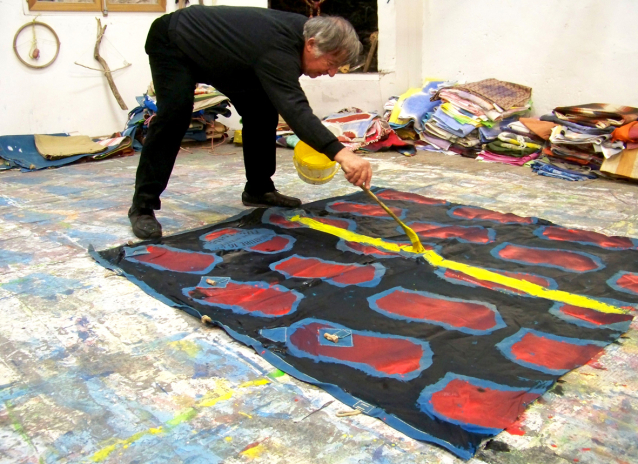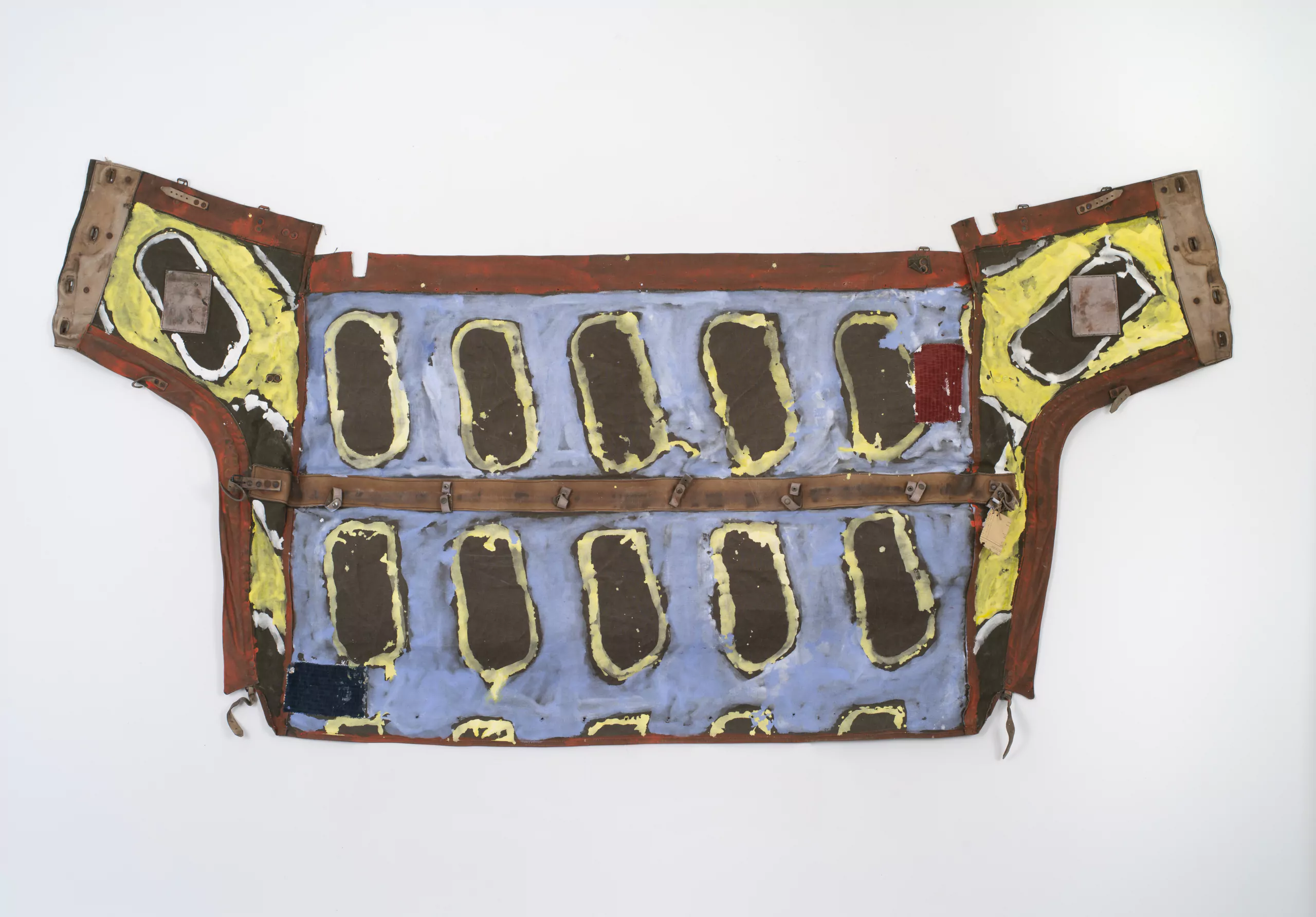
Claude Viallat: a realist painter
Essay
Romain Mathieu takes an uninhibited look at realism in the work of Claude Viallat, one of the founders of the Supports/Surfaces movement.
To write about the work of Claude Viallat is to deal with a form of painting that transcends the commentary it elicits. Viallat’s painting is primitivist, yet may take on pop art or kitsch accents when playing with the colored reflections of a sequined fabric. The monochromatic rows of forms in certain works have a remarkable asceticism, yet the painting also has a decorative luxuriance. The expanding formats are translated into an occupation of space, a strategy of surface covering that is immediately contradicted by the fillets, hoops, or thin ribbons within which the painting takes form in the spaces it creates. Viallat’s painting goes beyond interpretation, not only because of the vast quantity of canvases and objects produced but also because it defies contradiction and therefore the categories to which it might be confined, just as artists abolished the picture frame through the deconstruction of easel painting. To transcend any commentary is perhaps characteristic of any great work, but this is a distinctive aspect of the work of Claude Viallat in its principle of inversion of front and back, as in the front and back of the work’s surface, playing on itself over and over, at once reiterating itself in a movement that the artist himself describes as a “spiraling,” feeding on all it can take for itself.
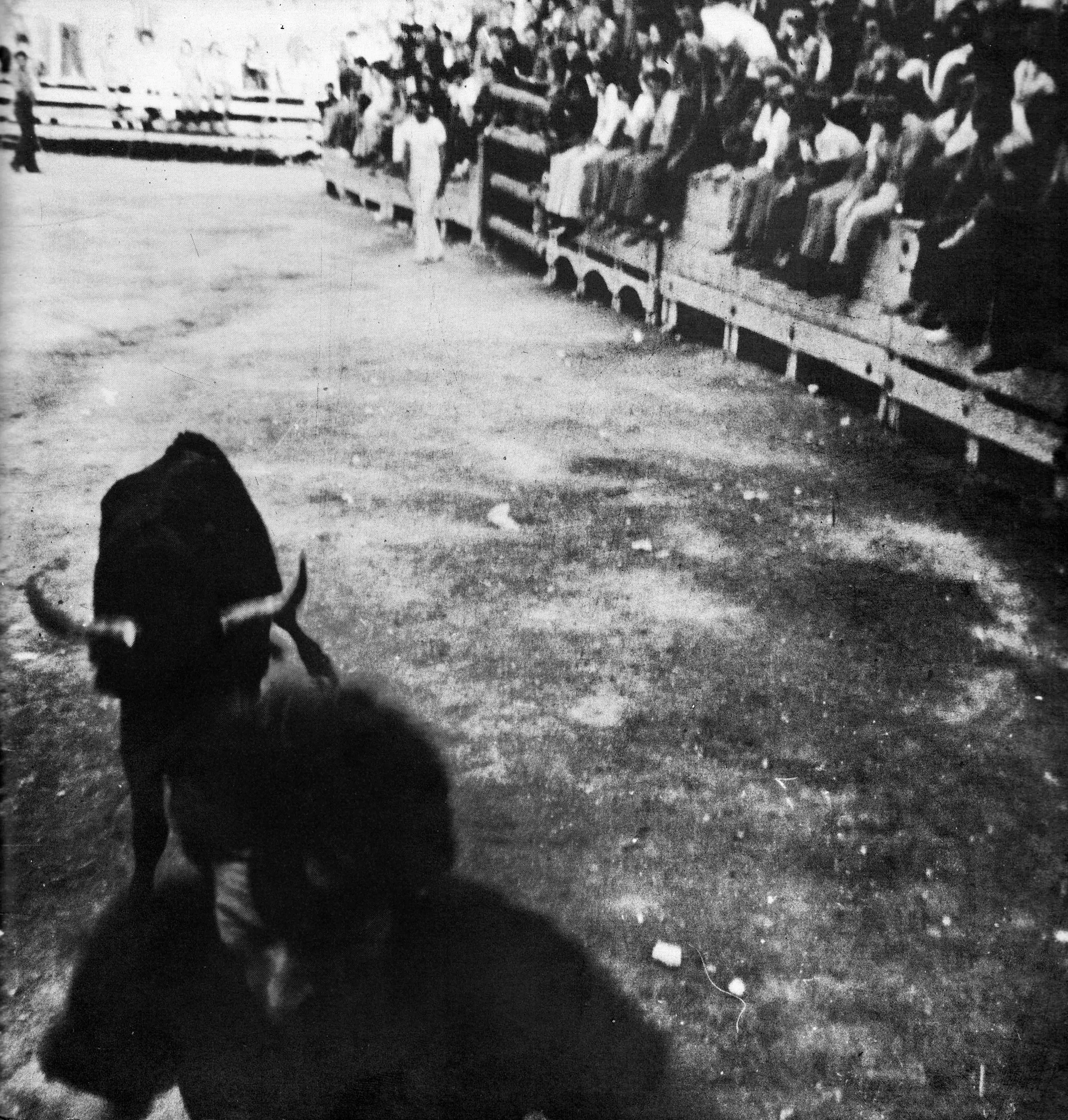
For this process of impression is one of taking, of taking in painting, of bringing a seemingly unlimited multiplicity of surfaces into the painting. It is significant that Viallat originally thought of the hand as the primary form—that prehensile hand which he later applied to pebbles and wood—before adopting a more neutral form devoid of any symbolism or label. There is something gargantuesque in Viallat’s work, a movement that absorbs materials, forms, and colors, besides art historical references and even his own paintings, redoing, in recent years, in different ways, what he has done before. But at the center of this movement of ingestion and digestion, it is not so much the artist that we perceive—his self-effacement before the pictorial process is perfectly captured in the 1974 publication of a photograph of Viallat at a course libre bullfight, as he moves out of the camera’s frame leaving the bull alone in the ring [1]; no, the heart of Viallat’s painting, the center of this spiraling movement, is rather the studio and with it the presence of the artist’s body.
Claude Viallat lives and works in Nîmes. An artist’s biography traditionally begins, before the list of exhibitions, with a somewhat abrupt indication of location, whose relevance may be purely administrative or practical, or have greater significance. Where Viallat is concerned, these few words constitute a sort of extremely condensed commentary, blending biography, work, and place: the artist’s studio. The artist’s exhibition at the Carré d’Art in Nîmes is therefore of particular significance, reflecting the close relationship between studio and city.
There is something gargantuesque in Viallat’s work,
a movement that absorbs materials,
forms and colors…
The studio is precisely the place where inside and outside meet. It is an enclosed space, set back from the street, inhabited and transformed by the painter’s work, with works on the wall or on the floor or elsewhere in the space, a mixture of recent canvases and objects and older works in which memories surface. It is a place into which fabrics, canvases, objects gathered by the artist or brought by friends flow and converge, in a sort of underground circulation that connects the studio, the city, and, through capillary action, the world. These many and varied traces of life, individual and collective stories, wash up here in this place to become paintings, like the driftwood that Viallat often uses for these objects and that comes from the wide beaches of the Camargue, where forms are shaped by the salt, water, and wind.
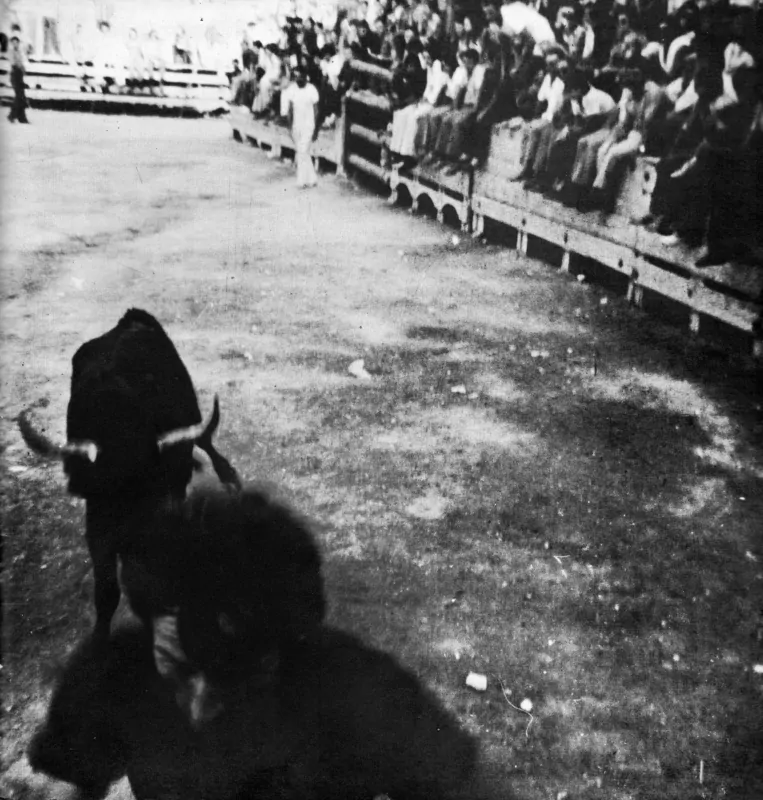
Claude Viallat passing the bull during a course libre in Aubais, c.1970
The other flow connecting the studio to the city is naturally that of corridas, but perhaps that flow should not be distinguished and taken as one element among others in this circulation, but simply one that is more intense, in the artist’s passion for the spectacle and in its being part of the city. Here, too, the corridas paintings, on their precarious surfaces, like a sort of primary, necessary figurative impulse, are accompanied by gathered and collected objects, indicating the clear connection between these works and the rest of the artist’s process.
This collecting of elements in the studio, in the assemblage of objects and the painting of fabrics, is a record of the shaping of forms by time and human life. This recording does not seek to elevate but to transform and to show what is present from a new perspective, through new expression. It reveals a past and gives a new existence in the present. Tent canvases, parasols, curtains, armchair materials, blinds, sheets, dresses… countless fabrics steeped in stories, places, eras, and also aesthetics and the desires from which they were born, and each of us might “recognize” some of them, from our own life history: a child’s bed sheet with a 1980s print, material for a stripy dress, a grandma’s curtain fabric, a café terrasse awning… Viallat’s painting does not cover; it absorbs, takes what there is, the sometimes complex formats turning into pictorial spaces, with the motifs and the materials, reacting differently to the application of the color. In this flow of life, art history mingles with the banal, as in the artist’s many Hommages, which are revealed in the relation between the painting and the materials, such as the Hommage à Zeuxis with the bunch-of-grapes motif on the fabric. It is tempting to compare this use of materials with collage, a technique that Viallat did in fact use in works before the adoption of his signature form in 1966. But collage is the integration into the picture of fragments that retain their alterity, as intrusions of the real in the pictorial space. With Viallat, this distinction disappears: the painting’s surface is one of its materials. The artist prefers joining to collage: in other words, the end-to-end joining of fragments that together become painting.
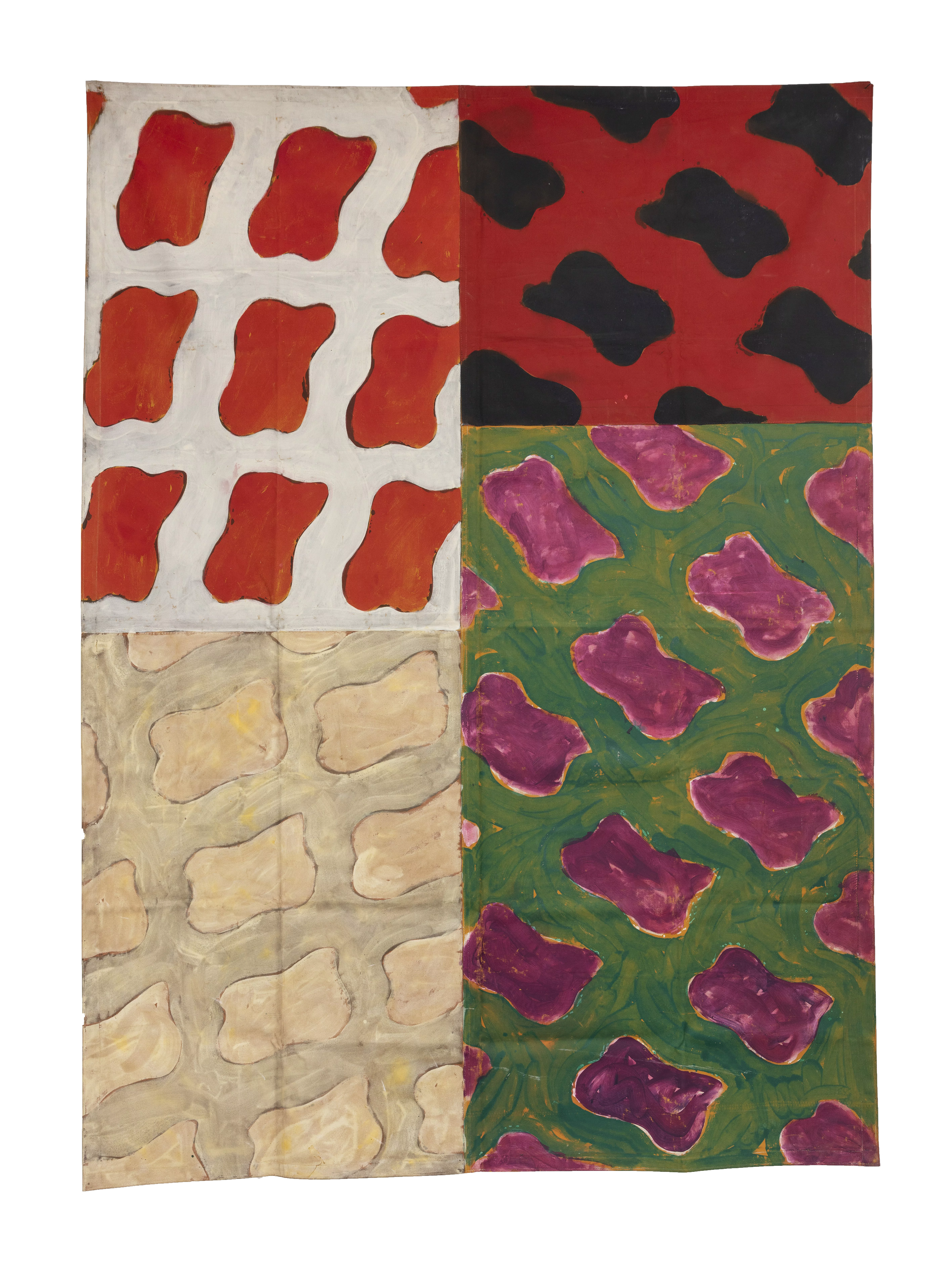
Claude Viallat’s painting rejects the image as the sole reality of the “work,” with the exception of the corridas. So it would seem far removed from any form of realism. And yet, when one leaves Viallat’s studio, after observing the works laid out over the floor and seeing their colors, after that extraordinary moment of the emergence of the painting in its folds and unfolding, another famous studio in the history of art springs to mind: that of Gustave Courbet and the painter’s depiction of it. [2] In that canvas, Courbet paints a landscape freehand, an unclothed woman standing next to him and a child looking at the work, the artist surrounded by the society of his time and his friends and family as well as ordinary people. Courbet declared, with regard to this painting, that “it is the world that comes to be painted at the studio.” [3]
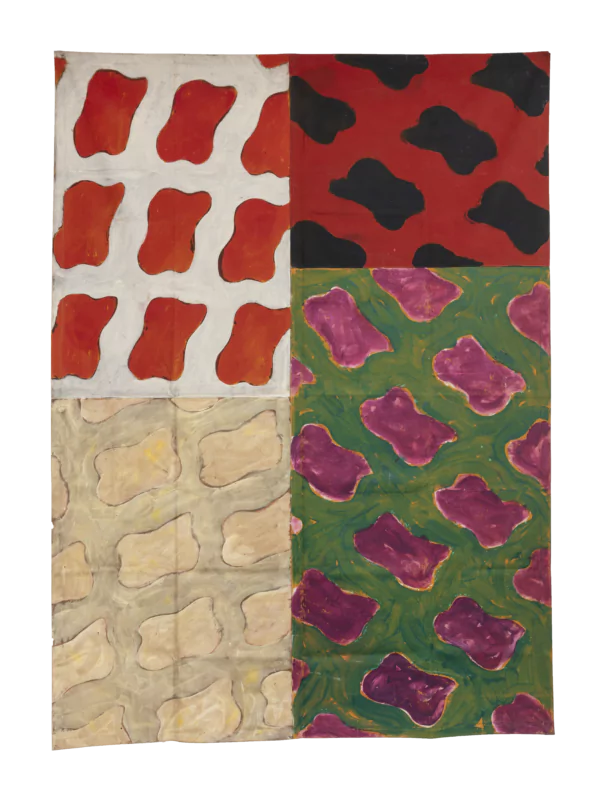
Sans titre, 1978. Acrylic on tarpaulin, 275,5 × 200 cm – 108 1/2 × 78 3/4 in.
With Claude Viallat, there is no depiction, of course, but the world also comes to be painted, literally. In 1861, Courbet wrote: “I maintain, in addition, that painting is an essentially concrete art and can only consist of the representation of real and existing things. It is a completely physical language, the words of which consist of all visible objects; an object which is abstract, not visible, non-existent, is not within the realm of painting. Imagination in art consists in knowing how to find the most complete expression of an existing thing, but never in inventing or creating that thing itself.” [4] There is no doubt that, for Viallat, painting is an absolutely concrete art, but “to find expression of an existing thing” is also an extremely pertinent definition of this artist’s painting, in the relation between color and surface.
While the term “realism” is highly ambiguous—Courbet himself said as much and I take the liberty of using the word here, too—it correlates with a quest for truth that was noted by the critics of Courbet’s painting at the presentation of his Atelier: he is “more concerned with truth than with beauty”. [5] The concern for truth is also present in the work of Viallat; it is essential in challenging the notion of painting as a scene and painting as a material process. But truth also lies in the relationship with the real that is part of Viallat’s painting. It is perhaps the corridas works that express this presence of the real most directly, not because of the images they create but because this concern for truth lies in the repetition of the bull motif, breaking into the painting like an element of the real. In bullfighting, the confrontation with the bull is wholly truthful—“in the ring everything is for real,” observed the famous toreador José Tomás. [6] How could it be otherwise, in that moment where the man stands between the bull’s horns, risking his life, and when naked, bloody reality prevails? Yet as Paco Aguado remarks, “each toreador to his own truth, so there are any number of truths in the toreo: ephemeral or eternal, light or profound, festive or tragic, self-evident or discreet, tough or delicate, fast-paced or slow, baroque or neoclassical, avant-garde, with tremendismo, artistic, warrior-like, in the style of El Gallo or of Belmonte… and all these truths demand from those who exhibit them on this chessboard of sand a raw sincerity; the very same as that demanded by the infallible judge that emerges unconsciously in our minds every afternoon from the darkness of the toril”. [7] In the insatiable repetition of the act of painting, the canvases of Claude Viallat are always exploring this multiple truth through which the real is shown: lavish or bare, festive or grave, serious or ironic, cheerful or melancholic, sunny or dark, anxious or carefree, sometimes feminine, often erotic. Among the many possible readings that it offers, Viallat’s work is a response to that fundamental aspiration of painting which is to paint the world. If Viallat’s artist’s studio is a bullring, it is not in reference to a struggle—to borrow the image used for the action painters—but because that aspiration requires the greatest sincerity with this world that enters and becomes painting. It is with this sincerity that Claude Viallat’s painting finds the most truthful expression of that which exists, and that his work is, in its way, a painting of history, of our individual and collective lives.
—
Claude Viallat, ‘Et pourtant si…’ Carré d’Art, Nîmes, France, October 27, 2023 — March 3, 2024.
Claude Viallat, ‘A Couple of Sidesteps’ Templon Brussels, until November 4, 2023.
Claude Viallat, ‘Hommage à la couleur. Toiles 1966 — 2023’ Templon Paris, November 8 — December 23, 2023.
ROMAIN MATHIEU is an art historian and art critic. He teaches at the École Supérieure d’Art et Design in Saint-Étienne and at Aix-Marseille University and has been published extensively, in France and abroad, on contemporary artists and the art of the 1960s and 1970s. He is a regular contributor to the magazine Artpress and was co-curator of the Artpress Biennial in 2020 and 2022. In 2017, he curated the exhibition “Supports/Surfaces – les origines 1966-1970” at Carré d’Art in Nîmes.
[1] Course libre bullfight, Aubais, 1969, photograph by Henriette Viallat, in Claude Viallat, exhibition catalogue, Musée d’Art et d’Industrie, Saint-Etienne, 1974.
[2] G. Courbet, L’Atelier du peintre, allégorie réelle déterminant une phase de sept années de ma vie artistique, 1855, oil on canvas, 359 x 598 cm, Paris, musée d’Orsay.
[3]P. Ten-Doesschate Chu, Correspondance de Courbet, Paris, Flammarion, 1996.
[4] Gustave Courbet, Peut-on enseigner l’art [“Art Cannot Be Taught”], (1861), Paris, L’.choppe, 2016.
[5] Théophile Gautier, “Salon de 1850-1851, M. Courbet,” fourth article. La Presse, February 15, 1851.
[6] José Tomás, Dialogue avec Navegante, French trans. François Zumbiehl, Vauvert, Au Diable Vauvert, 2013.
[7] Paco Aguado, “Vérités sur le sable de l’arène,” French trans. François Zumbiehl, in José Tomás, Dialogue avec Navegante, op. cit.
Claude Viallat was born in 1936 in Nimes, France, where he continues to live and work. He is one of the founders of the Supports/Surfaces movement in the 1970s, which called for art to renew itself through a deconstruction of traditional materials. Viallat started to work on industrial tarp, endlessly repeating the same abstract pattern, resembling a small bone, which became his signature. Stencilled repeatedly onto a range of supports, the pattern asks us to reflect on the meaning of the creative act and the status of the work of art.
